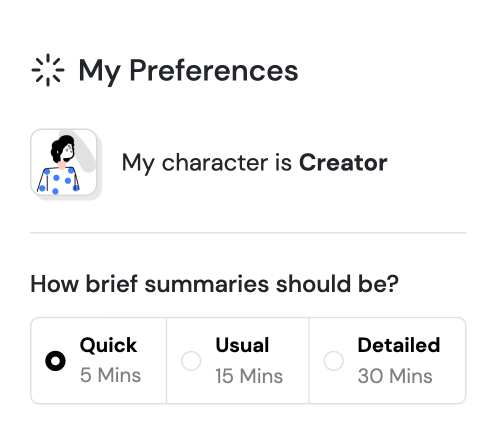
What to Say When You Talk to Yourself
What's it about?
Helmstetter in What to Say When You Talk to Yourself reveals how our internal dialogue shapes our thoughts, beliefs, and ultimately our actions. By learning to reprogram our self-talk, we can overcome limiting beliefs and achieve our full potential. With practical exercises and techniques, this book empowers readers to harness the transformative power of their own words. Say goodbye to self-doubt and hello to a more confident, resilient you!
About the Author
Shad Helmstetter is an author and self-help expert best known for his work on self-talk and its impact on personal development. His seminal book, "What to Say When You Talk to Your Self," introduces the concept of internal dialogue management as a tool for positive change. Helmstetter's writing combines practical advice with psychological insights.
10 Key Ideas of What to Say When You Talk to Yourself
Practice Positive Self-Talk
Replace negative thoughts and doubts with positive affirmations.
The reasoning behind this tactic is that the subconscious mind believes what it hears repeatedly.
By consciously practicing positive self-talk, you can reprogram your mindset, leading to improved self-esteem and a more optimistic outlook on life.
This method leverages the principle of neuroplasticity, which suggests that the brain can change its structure and function based on repeated emotional and mental activities.
Learn DeeperStart Your Day with Positive Affirmations: Each morning, before you dive into your daily routine, take a moment to affirm your worth, capabilities, and goals. Say things like 'I am capable of achieving my goals,' or 'Today, I choose to focus on what I can control and let go of what I can't.'
Replace Negative Thoughts as They Arise: Whenever you catch yourself thinking negatively, pause and consciously replace the thought with a positive one. For example, if you think 'I can't do this,' immediately counter it with 'I can do this, I just need to approach it differently.'
Create a Positivity Journal: Every evening, write down three positive things about your day or about yourself. This could be achievements, compliments you received, or simply something you're grateful for. Over time, this practice reinforces a positive mindset.
Use Positive Language in Conversations: When talking to others, focus on using positive language. This not only improves your own mindset but can also positively affect those around you. For instance, instead of saying 'This is impossible,' say 'Let's see how we can overcome this challenge.'
- Example
If you're preparing for a job interview and feel anxious, instead of dwelling on the fear of failure, affirm to yourself: 'I have prepared well for this interview. I am qualified and will present myself confidently.'
- Example
When faced with a difficult task at work, rather than thinking 'I've never done this before, so I'll probably mess it up,' tell yourself: 'This is a great opportunity to learn something new. I'll tackle it step by step and ask for help if I need it.'
Identify and Challenge Negative Beliefs
Actively identify negative beliefs and challenge their validity.
This involves questioning the evidence for these beliefs, considering alternative viewpoints, and testing these beliefs against reality.
The argument for this tactic is that many negative beliefs are not based on facts but rather on irrational fears or misconceptions.
By challenging these beliefs, you can reduce their power over you and replace them with more accurate and constructive thoughts.
Learn DeeperKeep a Thought Journal: Every day, jot down any negative thoughts that cross your mind. This will help you become more aware of the frequency and nature of your negative beliefs.
Question the Belief: For each negative thought, ask yourself, 'What evidence do I have that this thought is true? Is there evidence that contradicts this belief?' This helps in assessing the validity of your negative thoughts.
Reframe Your Thoughts: Once you've identified a negative belief and challenged its validity, try to reframe it in a positive or neutral way. For example, change 'I'll never be good at this' to 'I'm improving every day with practice.'
Seek Alternative Perspectives: Discuss your negative beliefs with trusted friends or family members. They can offer different viewpoints that might challenge your negative beliefs and support you in seeing things differently.
Test Your Beliefs: Set small, manageable goals that challenge your negative beliefs. For instance, if you believe you're not good at public speaking, try speaking in front of a small, supportive group and gradually increase the audience size as you become more comfortable.
- Example
If you frequently think 'I'm not smart enough to succeed in my career,' start by writing this thought in your journal. Then, list all the instances where you've succeeded or received praise at work as evidence against this belief. Reframe the thought to 'I have the skills and intelligence to succeed in my career, and I'm always learning more.'
- Example
Imagine you often think 'I'm too awkward in social situations.' Challenge this by recalling times when you had enjoyable interactions or received positive feedback in social settings. Reframe it to 'I can be sociable and connect well with others when I'm genuinely myself.' Then, make a point to initiate conversations in social settings, starting with familiar faces and gradually expanding your comfort zone.
Set Specific Goals for Your Self-Talk
Define clear, specific goals for what you want to achieve through your self-talk.
This could include improving confidence, overcoming a fear, or achieving a particular objective.
The reasoning here is that specific goals provide direction for your self-talk, making it more focused and effective.
Goals also offer a way to measure progress, which can motivate further positive self-dialogue.
Learn DeeperIdentify Your Goals: Start by taking some time to reflect on what you really want to achieve. This could be anything from becoming more assertive at work, to running a marathon. Write these goals down in clear, specific terms.
Craft Your Self-Talk Statements: For each goal, create positive self-talk statements that reinforce your ability to achieve it. For example, if your goal is to improve public speaking, your self-talk might be 'I am confident and articulate when speaking in front of others.'
Schedule Regular Self-Talk Sessions: Set aside a few minutes each day to practice your self-talk. This could be in the morning as you get ready for the day, or during a break when you need a boost.
Track Your Progress: Keep a journal of your self-talk practice and any progress you notice towards your goals. Celebrate small victories to motivate yourself to keep going.
Adjust as Needed: If you find certain self-talk statements aren't helping, or your goals change, adjust your approach. The key is to make your self-talk work for you and your unique objectives.
- Example
If your goal is to increase your fitness level, your specific self-talk might be 'I am strong, energetic, and enjoy exercising daily to improve my health.' You could repeat this statement during your morning routine to start your day with a positive mindset towards physical activity.
- Example
For someone aiming to improve their financial management, a self-talk statement could be 'I am capable of managing my finances wisely and making smart spending decisions.' This could be reinforced by repeating the statement each time you review your budget or make financial decisions.
Use Visualization Techniques
Combine positive self-talk with visualization.
Imagine yourself successfully achieving your goals or handling situations confidently.
Visualization strengthens the impact of positive self-talk by engaging the brain's regions associated with perception and action.
This engagement enhances motivation and increases the likelihood of taking action towards your goals.
Learn DeeperStart Small: Begin by visualizing small, easily achievable goals. This could be as simple as seeing yourself completing a daily task with ease or having a positive interaction with a colleague. The key is to make it vivid and detailed in your mind.
Incorporate Daily: Set aside a few minutes each day for visualization. Find a quiet space, close your eyes, and vividly imagine yourself achieving a specific goal. Focus on the feelings of success, the sounds around you, and the visual details of the achievement.
Pair with Positive Self-Talk: While visualizing, consciously engage in positive self-talk. Tell yourself that you are capable, prepared, and successful. This combination reinforces your belief in your ability to achieve your goals.
Use a Vision Board: Create a vision board with images and words that represent your goals. Place it somewhere you will see it daily. This serves as a constant visual reminder of what you're working towards and can enhance your visualization practice.
Reflect and Adjust: Regularly reflect on your visualization experiences. Consider what's working and what isn't. Adjust your approach as needed, perhaps by choosing different times of day, altering your goals, or changing your self-talk scripts.
- Example
Imagine you're preparing for a job interview. Spend time visualizing yourself walking into the interview room, confidently greeting the interviewers, and answering questions with ease. Pair this with positive self-talk, reminding yourself of your qualifications and past successes.
- Example
Visualize completing a challenging workout. See yourself pushing through the tough moments, feeling strong and capable. Use positive self-talk to remind yourself of your fitness goals and your ability to achieve them.
Create Personalized Affirmations
I am confidently pursuing my goals every day.
I embrace challenges as opportunities for growth.
I attract positive energy and supportive relationships into my life.
I am worthy of love, success, and happiness.
I trust my intuition and make decisions that align with my values.
I am grateful for the abundance that surrounds me.
I prioritize my well-being and nurture my body and mind.
I am capable of achieving my dreams and aspirations.
I radiate positivity and inspire those around me.
I celebrate my progress and acknowledge my achievements.
Identify Your Goals and Desires: Start by clearly defining what you want to achieve or change in your life. This could be anything from improving self-confidence, achieving a career milestone, or fostering better relationships.
Craft Your Affirmations: Based on your goals, create affirmations that are specific to your needs. Remember to keep them positive, in the present tense, and precise. For example, instead of saying 'I will be confident,' say 'I am confident in my abilities.'
Incorporate Affirmations into Your Daily Routine: Set aside time each day to repeat your affirmations. This could be in the morning when you wake up, during your commute, or before you go to bed. Consistency is key.
Reflect and Adjust: Over time, reflect on the impact of your affirmations. If you find certain affirmations aren't resonating as you'd hoped, don't hesitate to adjust them. The goal is to find phrases that truly motivate and inspire you.
- Example
If your goal is to improve self-esteem, an affirmation might be: 'I am worthy of love and respect from myself and others.' Repeat this affirmation daily while looking in the mirror.
- Example
For career advancement, an affirmation could be: 'I possess the skills and knowledge required for success in my career.' Visualize yourself achieving your career goals as you affirm this statement.
Deeper knowledge. Personal growth. Unlocked.
Unlock this book's key ideas and 15M+ more. Learn with quick, impactful summaries.
Read Full SummarySign up and read for free!
What to Say When You Talk to Yourself Summary: Common Questions
Experience Personalized Book Summaries, Today!
Discover a new way to gain knowledge, and save time.
Sign up for our 7-day trial now.
No Credit Card Needed

Similar Books

The Piano Teacher
Elfriede Jelinek
The Courage To Be Disliked
Ichiro Kishimi
We Were Liars
E. Lockhart
The Art of Solution Focused Therapy
Elliott Connie, MA, LPC
The Science of Storytelling
Will Storr
No Longer Human
太宰治
Wanting
Luke Burgis
Mrs Dalloway
Virginia Woolf
The Rational Optimist
Matt Ridley
The Social Animal
David BrooksTrending Summaries

Peak
Anders Ericsson
Never Split the Difference
Chris Voss
Smart Brevity
Jim VandeHei
The Psychology of Money
Morgan Housel
The First 90 Days
Michael D. Watkins
Atomic Habits
James Clear
Thinking, Fast and Slow
Daniel Kahneman
The Body Keeps the Score
Bessel van der Kolk M.D.
The Power of Regret
Daniel H. Pink
The Compound Effect
Darren HardyNew Books

The Art of Spending Money
Morgan Housel
$100M Offers
Alex Hormozi
A Candle for Kiri
Edna Mae Holm
Principles of Marketing, Global Edition
Gary Armstrong
Serpent Rising: The Kundalini Compendium
Neven Paar
Feeling Is the Secret
Neville Goddard
The 100 Best Business Books of All Time
Jack Covert
My Oxford Year
Julia Whelan
Trading in the Zone
Mark Douglas
